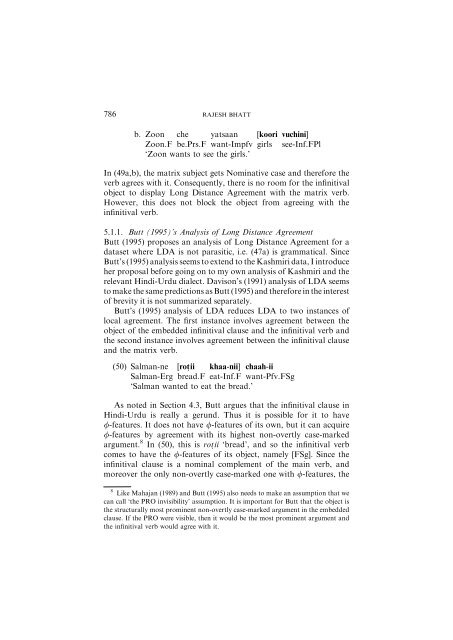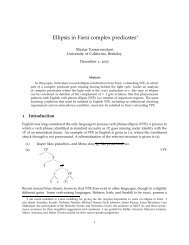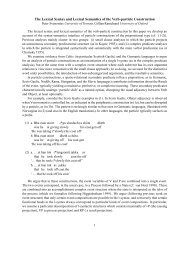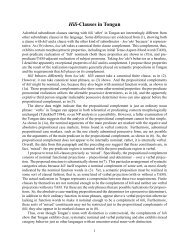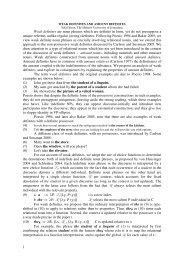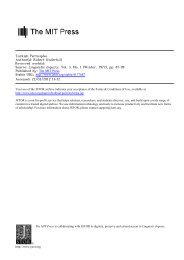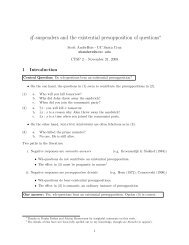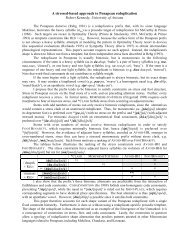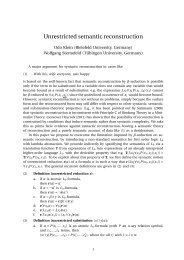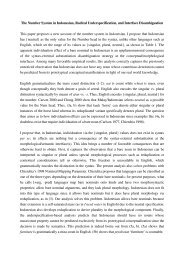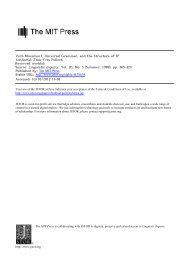LONG DISTANCE AGREEMENT IN HINDI-URDUw This paper ...
LONG DISTANCE AGREEMENT IN HINDI-URDUw This paper ...
LONG DISTANCE AGREEMENT IN HINDI-URDUw This paper ...
Create successful ePaper yourself
Turn your PDF publications into a flip-book with our unique Google optimized e-Paper software.
786RAJESH BHATTb. Zoon che yatsaan [koori vuchini]Zoon.F be.Prs.F want-Impfv girls see-Inf.FPl‘Zoon wants to see the girls.’In (49a,b), the matrix subject gets Nominative case and therefore theverb agrees with it. Consequently, there is no room for the infinitivalobject to display Long Distance Agreement with the matrix verb.However, this does not block the object from agreeing with theinfinitival verb.5.1.1. Butt (1995)’s Analysis of Long Distance AgreementButt (1995) proposes an analysis of Long Distance Agreement for adataset where LDA is not parasitic, i.e. (47a) is grammatical. SinceButt’s (1995) analysis seems to extend to the Kashmiri data, I introduceher proposal before going on to my own analysis of Kashmiri and therelevant Hindi-Urdu dialect. Davison’s (1991) analysis of LDA seemsto make the same predictions as Butt (1995) and therefore in the interestof brevity it is not summarized separately.Butt’s (1995) analysis of LDA reduces LDA to two instances oflocal agreement. The first instance involves agreement between theobject of the embedded infinitival clause and the infinitival verb andthe second instance involves agreement between the infinitival clauseand the matrix verb.(50) Salman-ne [rot:ii khaa-nii] chaah-iiSalman-Erg bread.F eat-Inf.F want-Pfv.FSg‘Salman wanted to eat the bread.’As noted in Section 4.3, Butt argues that the infinitival clause inHindi-Urdu is really a gerund. Thus it is possible for it to have/-features. It does not have /-features of its own, but it can acquire/-features by agreement with its highest non-overtly case-markedargument. 8 In (50), this is rot:ii ‘bread’, and so the infinitival verbcomes to have the /-features of its object, namely [FSg]. Since theinfinitival clause is a nominal complement of the main verb, andmoreover the only non-overtly case-marked one with /-features, the8 Like Mahajan (1989) and Butt (1995) also needs to make an assumption that wecan call ‘the PRO invisibility’ assumption. It is important for Butt that the object isthe structurally most prominent non-overtly case-marked argument in the embeddedclause. If the PRO were visible, then it would be the most prominent argument andthe infinitival verb would agree with it.


